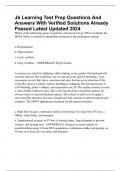Jb Learning Test Prep Questions And
Answers With Verified Solutions Already
Passed Latest Updated 2024
Which of the following causes of pulseless electrical activity (PEA) would be the
MOST likely to respond to immediate treatment in the prehospital setting?
a. Hypokalemia
b. Hypovolemia
c. Lactic acidosis
d. Drug overdose - ANSWER✔✔b. Hypovolemia
A woman was struck by lightning while working in her garden. Her husband tells
you that when he first found her, she was unconscious and not breathing. Your
assessment reveals that she is conscious and alert, but has no recollection of the
event. Her airway is patent, and her breathing is adequate. Her blood pressure is
134/74mmHg, pulse is 88bpm, and respirations are 20. The cardiac monitor reveals
a sinus rhythm without ectopy. She is moving all of her extremities and has no
obvious burns or musculoskeletal injuries. She refuses to allow you to apply a
cervical collar and place her onto a backboard, but consents to other treatment and
transport. The MOST appropriate treatment for this patient includes:
a. High flow oxygen, continuous cardiac monitoring, two large-bore IV lines, a
500mL saline bolus, and transport
b. Supplemental oxygen, an IV line of normal saline, 5mg diazepam to prevent
seizures, and prompt tran - ANSWER✔✔d. Oxygen via nasal cannula or
nonrebreathing mask, 12 lead ECG acquisition, continuous cardiac monitoring, an
IV line set to keep the vein open, and transport
,You are preparing to defibrillate a patient in cardiac arrest with a manual biphasic
defibrillator, but are unsure of the appropriate initial energy setting. What should
you do?
a. Contact medical control for further guidance
b. Deliver three sequential shocks with 120 joules
c. Deliver one shock with 200 joules and resume CPR
d. Continue CPR and shock with 360 joules in 2 minutes - ANSWER✔✔
A 70-year-old woman was suddenly awakened with the feeling that she was
suffocating. She is anxious, is laboring to breathe, and has dried blood on her lips.
The ECG shows the cardiac rhythm below. Which of the following
pathophysiologies BEST describes her clinical presentation?
a. Increased stroke volume with right heart failure
b. Increased preload with left heart failure
c. Decreased preload with right heart failure
d. Decreased stroke volume with left heart failure - ANSWER✔✔d. Decreased
stroke volume with left heart failure
You are assessing a 67-year-old female with chest discomfort when she becomes
unresponsive, apneic, and pulseless. The cardiac monitor reveals coarse ventricular
fibrillation. You achieve return of spontaneous circulation after 4 minutes and the
cardiac monitor now reveals a narrow complex rhythm. The patient is still
unresponsive, has occasional respirations, blood pressure of 70/40 and a weak
pulse of 70. The MOST appropriate post resuscitation care for this patient includes:
,a. Insertion of an airway adjunct, assisted ventilation with a bag-valve-mask
device, vascular access, a 500-1000mL crystalloid fluid bolus, and an amiodarone
infusion at 1mg/min.
b. Preoxygenation with a bvm and high flow oxygen, endotracheal intubation,
vascular access, 300mg of amiodarone, and a dopamine infusion.
c. Insertion of a supraglottic airway device, ventilatory assistance, vascular access,
150mg of amiodarone over 10 minutes, and - ANSWER✔✔a. Insertion of an
airway adjunct, assisted ventilation with a bag-valve-mask device, vascular access,
a 500-1000mL crystalloid fluid bolus, and an amiodarone infusion at 1mg/min
A middle aged man presents with Chest discomfort, shortness of breath, and
nausea. You give him supplemental o2 and continue your assessment. As your
partner is attaching the ECG leads, you should:
a. Establish vascular access
b. Administer 2 to 4mg morphine IV
c. Administer up to 325mg of aspirin
d. Administer 0.4mg of nitroglycerine - ANSWER✔✔c. Administer up to 325mg
of aspirin
You have defibrillated a patient who presented with ventricular fibrillation. After 2
minutes of CPR, you reassess the patient's cardiac rhythm and see a wide-complex
tachycardia. You should:
a. Cardiovert with the energy you used to defibrilate
b. Administer 300mg of amiodarone via rapid IV or IO push
c. Defibrillate and then immediately resume chest compressions
d. Check for a carotid pulse and defibrillate if a pulse is absent - ANSWER✔✔d.
Check for a carotid pulse and defibrillate if a pulse is absent
, Which of the following signs would indicate a severe pericardial tamponade?
a. Strengthening of the pulse during the inhalation phase
b. A rise in systolic blood pressure and a fall in the diastolic pressure
c. Collapsed jugular veins when the patient is placed at a 45-degree angle
d. A drop in the blood pressure of greater than 10mmHg during inhalation -
ANSWER✔✔
When assessing a middle-aged man who complains of nausea and weakness, he
suddenly becomes unresponsive. The cardiac monitor shows that he is in
ventricular fibrillation. After determining that he is apneic and pulseless, you
should:
a. Perform synchronized cardioversion
b. Start CPR and prepare to defibrillate
c. Perform CPR for 2 minutes and defibrillate
d. Start an IV and give 300mg of amiodarone - ANSWER✔✔b. Start CPR and
prepare to defibrillate
A 47-year-old male took two of his prescribed nitroglycerine tablets prior to
calling EMS. When you arrive at the scene, the patient tells you that he has a
throbbing headache and is still experiencing chest pain. Your MOST immediate
suspicion should be that:
a. His chest pain is probably not of a cardiac origin
b. He is experiencing continued myocardial ischemia
c. His nitroglycerine is outdated or has lost its potency




